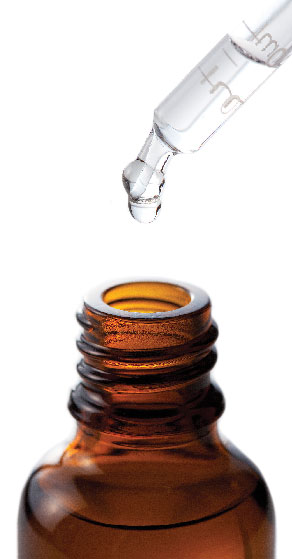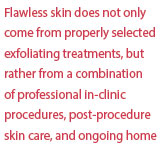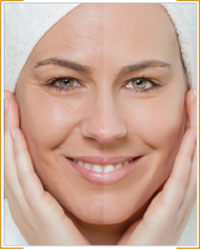In this new era of anti-aging skin exfoliating solutions, techniques, and devices for correcting unwanted intrinsic and extrensic epidermal issues, safety is of primary concern for the practical aesthetician.
It is common practice to include exfoliation for the skin’s overall health and appearance as part of an individual treatment session. Removing dead skin cells and stimulating the skin’s regeneration processes is essential to complexion perfection.
 Skin Assessment
Skin Assessment
Before any treatment plan can be determined, it will be necessary to complete a thorough skin analysis and medical history assessment that includes skin type, skin condition, current home care product regimen, lifestyle, and expectations.
 Home Care and Client Compliance
Home Care and Client Compliance
Flawless skin does not only come from properly selected exfoliating treatments, but rather from a combination of professional in-clinic procedures, post-procedure skin care, and ongoing home care maintenance regimens. The success of each treatment program depends heavily on home care compliance, so it is important to teach on the use of melanin suppressing agents and sunscreen application as part of the consultation and home care instruction prior to the peel application.
In addition to daily sunscreen application, melanin suppressing agents are a requirement for home care in order to progress peel intensity for greater skin rejuvenating results. Compliance to product formulations containing:
Vitamin C, a powerful antioxidant that provides protection against skin damage induced by ultraviolet radiation, reduces erythema, promotes wound healing, and suppresses cutaneous pigmentation.
Chromanyl palmitate, an active molecule for skin brightening with a higher melanin inhibiting effect than arbutin or kojic acid.
Hydroquinone, an effective ingredient for inhibiting melanin production, reducing the potential for red and brown discoloration ofthe skin.
Applying tyrosinase inhibitors can be compared to giving melanocyte cells a sedative; it calms down their rate of melanin production to condition the skin for more intensive peeling treatments, lowering the client’s risk of post-peel complications.
Peeling Agents Defined
Before applying any advanced peel protocol where combinations of peel layers are used in tandem with a mechanical device, you must have an in-depth knowledge of how the client’s skin responds to this kind of intensive stimulation. It may take two or three treatment sessions, using lower concentrations of exfoliating ingredients to determine tolerance and sensitivity.
A guiding principle for aestheticians applying exfoliating solutions and devices must be to “First Do No Harm.” With that said, I have found that using a gradual intensity of peeling modalities over a series of sessions is an efficacious and safe protocol in most skin rejuvenation cases. Starting clients’ treatments with an enzyme peel, then graduating to an acid peel before progressing to chemical exfoliation helps to build tolerance and avoid complications.
 Enzyme Peels
Enzyme Peels
Enzymes such as bromelain, papain, and pancreatin are known for naturally dissolving the keratinized protein layer of the skin, creating a gentle exfoliation safe for all skin types and ethnicities. Because they soften, loosen, and lift dead cell debris without disrupting the pH balance and stripping the epidermal barrier of the skin, enzymes are highly recommended as first-time peels or instant radiance peels to reveal a healthy, new layer of smooth and youthful looking skin. However, if your client experiences any discomfort during the peel, it is recommended to discontinue the treatment by using cold water compresses.
Acid Peels
While enzymes dissolve the dead skin cells primarily composed of keratin, alpha, and beta, hydroxy acids dissolve oil to create a deeper release of dead skin cells. Alpha hydroxy acids (AHAs) are water-soluble and are good at dissolving the outermost layers of dead skin cells, while lipid-soluble beta hydroxy acid (BHA) molecules penetrate deeper into the hair follicle to clear congested pores. The nature of acid peels is to disrupt the natural moisture balance of the skin barrier, creating accelerated exfoliation for the correction of problematic, age-related skin conditions.
The following list of the most common acids can be customized and layered, depending on the client’s skin type:
 Glycolic acid (AHA) is one of a group of acids extracted from natural sources used to remove the buildup of dead skin cells. Glycolic works by dissolving the intercellular lipids (oils) that hold dead cells on the skin surface. Out of this group of acids, glycolic acid is the most useful for cosmetic treatment because of its small molecular structure, allowing for greater penetration. Alpha hydroxy acid peels resulting in desquamation are determined by the concentration of the acid, the pH of the formulation, the amount of acid delivered to the skin, frequency of use and most importantly, the duration of time the acid is left on the skin. Glycolic provides an excellent exfoliation for all non-sensitive skin types.
Glycolic acid (AHA) is one of a group of acids extracted from natural sources used to remove the buildup of dead skin cells. Glycolic works by dissolving the intercellular lipids (oils) that hold dead cells on the skin surface. Out of this group of acids, glycolic acid is the most useful for cosmetic treatment because of its small molecular structure, allowing for greater penetration. Alpha hydroxy acid peels resulting in desquamation are determined by the concentration of the acid, the pH of the formulation, the amount of acid delivered to the skin, frequency of use and most importantly, the duration of time the acid is left on the skin. Glycolic provides an excellent exfoliation for all non-sensitive skin types.
Lactic acid (AHA) is derived from milk protein or synthetically manufactured. While lactic acid works much the same way as glycolic acid, it does not have the same dehydrating effects because its molecules are larger, therefore, it is less permeable and milder on the skin. It is also a natural humectant which is why it is considered to be an excellent exfoliator for drier, sensitive skin.
Malic acid (AHA) is derived from apples, berries and other fruits. This alpha hydroxy acid softens, exfoliates, increases cell turnover, and promotes circulation. The antioxidant properties of malic acid offer considerable moisturizing benefits for the skin. Malic acid imparts a very smooth, almost slippery, consistency to products. When applied to the skin, malic acid leaves a protective, moisturized coat on the skin.
Citric acid (AHA) is found in citrus fruits and is a natural preservative, cleansing agent, and antioxidant. It is an essential contributor to the formation of the left-handed andenosine triphosphate (ATP), the body’s most important energy source, formed in the citric acid cycle.
Tartaric acid (AHA) is from bearberry, the only chirally correct skin lightener.
L-Malic acid (AHA) from berries, promotes circulation and healthier capillaries in skin.
Salicylic acid (BHA) is extracted from wintergreen and willow bark in low concentrations. Salicylic acid is a natural anti-inflammatory, antibacterial and is best used as a peeling solution for oily acne skin conditions because of its ability to penetrate the pores and provide rapid healing of active lesions.
 Chemical Peels
Chemical Peels
Chemical peels are an excellent treatment choice as part of a progressive peel plan for severe, stubborn skin anomalies that do not fully resolve from the application of enzyme and acid peels. Determining the right chemical peel for each client requires a combination of knowing the skin pathology, the desired client results, and performance of the solutions used to produce deep cell rejuvenation. The client’s ability to go through a recovery period will be an important factor in the peel selection. Two of the most popular chemical peel solutions are Jessner’s solution and trichloracetic acid (TCA).
Application of the Jessner’s solution may be light or heavy, depending on preparation of facial skin prior to the peel (pre-peel degreasing); the number of layers applied will be determined by the clinical appearance of the skin and individual tolerance. The peel may be repeated at two to four month intervals, depending on the depth of the previous peel. Superficial pathologies may exhibit immediate improvement, whereas deeper problems may respond to repeated applications.
Trichloracetic acid is considered to be the gold standard of peeling agents. Trichloracetic acid can be used to treat a wide range of clients for age-related skin conditions like pigment disorders, photo-aged skin, fine lines, light to deep wrinkles, actinic keratosis, acne scarring, and thick or unevenly textured skin. Trichloracetic peels range from superficial epidermal exfoliation to deep dermal peeling, depending on the concentration used and number of layers applied. Ten to 25 percent trichloracetic acid concentrations superficially exfoliate the outer layers of the epidermis and may be safely repeated monthly for a wide variety of skin conditions, offering minimal recovery time with little disruption of daily routines. Skin care specialists must check their individual state board rules and regulations to determine if trichloracetic acid peels are within their scope of practice. Chemical peels may be applied to the face, neck, chest, and hands.
While chemical peel complications are rare and unlikely, there is a potential for systemic toxicity. This small risk may be minimized by avoiding application to large surface areas at the same time.
Chemical peels promise a dramatic improvement for the client undergoing this procedure, but the client must be made aware of the discomfort and risks such as temporary redness, visible flaking and peeling, allergic reaction, and possible post-inflammatory hyperpigmentation associated with this level of exfoliation.
Post Chemical Peel Care
As discussed earlier, emphasizing proper home care with the client before administering any in-clinic peeling treatment is essential. It is extremely important to be sure the client will comply with your post care instructions to avoid any adverse effects and to ensure results. Remind clients to avoid exercise for 48 hours, sleep on their back with their head elevated, not to apply makeup immediately, refrain from picking shedding and peeling skin, and contact the clinic immediately if there is a complication.
In-Conclusion
The use of skin peeling agents has been around for more than 3,000 years and while the deeper chemical peels theoretically provide bigger and better results, I believe that a series of less invasive, lighter enzyme and acid peels graduated to intensive, deep chemical peels can achieve impressive results without the inherent risks usually associated with resurfacing agents and procedures.
Master aesthetician Lyn Ross founded Institut’ DERMed 27 years ago with the goal of empowering skin care specialists with knowledge and proven treatment systems for optimal success. The company, located in Atlanta, currently consists of a medical spa, a full line of cosmeceutical products distributed to spas nationally and internationally, and the Institut’DERMed College of Advanced Aesthetics. Ross is a published author, with two books currently in print. Her articles appear in industry and trade magazines throughout the United States and worldwide.
Want to read more?
Subscribe to one of our monthly plans to continue reading this article.